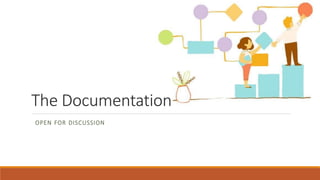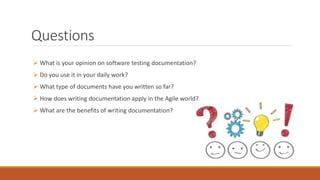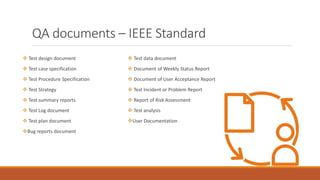Documentation in Software Testing
- 1. The Documentation OPEN FOR DISCUSSION
- 2. Questions ? What is your opinion on software testing documentation? ? Do you use it in your daily work? ? What type of documents have you written so far? ? How does writing documentation apply in the Agile world? ? What are the benefits of writing documentation?
- 3. Your Opinions on Documentation ? It is a must and a crucial part of testing ?It should be limited to only useful documents, adapted according to projects needs. ? Agile Manifesto: Ī░working software over comprehensive documentationĪ▒ ? Time consuming, but very useful for knowledge transfer.
- 4. Used in daily work?
- 5. QA documents ©C IEEE Standard ? Test design document ? Test case specification ? Test Procedure Specification ? Test Strategy ? Test summary reports ? Test Log document ? Test plan document ?Bug reports document ? Test data document ? Document of Weekly Status Report ? Document of User Acceptance Report ? Test Incident or Problem Report ? Report of Risk Assessment ? Test analysis ?User Documentation
- 6. Agile Context ©C your answers ? Testing has priority against documentation. But it has to be done sooner or later. ? Usually only what you need, when you have the time. PO's don't see documentation as a deliverable and time is rarely book for this. ? Only the strictly necessary. The documentation should be concise, on the point. ? Forced to keep the documentation short and simple.
- 7. Agile Context ©C What You Need ? A test strategy that describes how the system is usually tested. ? A test plan for each sprint. ? Test specifications which contain test cases. ? Test Ideas for exploratory testing and test logs in which the outcome is noted. ? Checklists for installation testing and regression testing.
- 8. Benefits ? Gives a good project understanding ? A better record of the testing activity performed on the project. ? Ensure internal co-ordination in client work ? Provide feedback for preventive actions ? It's needed for creating a knowledge base, knowledge transfer.
- 9. Best Practices: Writing ? Prefer executable specifications over static documents ? Document stable concepts, not speculative ideas ? Generate system documentation
- 10. BP: Simplification ? Keep documentation just simple enough, but not too simple ? Write the fewest documents with least overlap ? Put the information in the most appropriate place ? Display information publicly
- 11. BP: What to Document ? Document with a purpose ? Focus on the needs of the actual customers(s) of the document ? The customer determines sufficiency
- 12. BP: When to Document ? Iterate, iterate, iterate ? Find better ways to communicate ? Start with models you actually keep current ? Update only when it hurts
- 13. Questions Time













